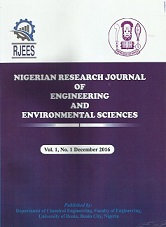A D-Optimal Design Method for the Formulation of a Non-Edible Binary Oil Blend as a Feedstock for Biodiesel Production
Authors: *Amenaghawon, N.A., Francis, E.D. And Ovuakporaye, A.B.
DOI Info: http://doi.org/10.5281/zenodo.16780504
ABSTRACT
The increasing dependence on fossil fuels and their adverse environmental impact necessitates the development of sustainable alternatives. Biodiesel, a fuel derived from vegetable oils, offers a promising solution. However, using edible oils for biodiesel production raises concerns about competition with food security as seen in several studies hence, this research. This study explores the viability of a non-edible oil blend (neem and yellow oleander oil) as a feedstock for biodiesel production. To formulate an optimal blend of the two feedstocks for biodiesel production, a D-Optimal mixture design was employed on the blends in different ratios. This approach allowed the identification of the blend ratios that maximized the oil blend for biodiesel production while improving its properties compared to using the individual oils. Characterization of both oils individually and as a blend was carried out to determine their properties. The result obtained from the numerical optimization identified the optimal blend of neem seed oil and yellow oleander oil in the proportions 16.15% and 83.85% respectively. Individually, the neem oil and yellow oleander had FFA of 9.59 and density of 905 kg/m3, respectively. The presence of this low FFA and density, demonstrates the potential of the oil blend to give a high yield for biodiesel production than using the neem oil and yellow oleander individually.
Affiliations: Bioresources Valorization Laboratory, Department of Chemical Engineering, Faculty of Engineering, University of Benin, Nigeria.
Keywords: Biodiesel, Neem Seed Oil, Yellow Oleander, D-optimal, Oil Blend, Optimization
Published date: 2025/06/30









